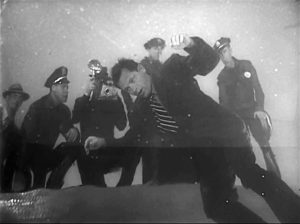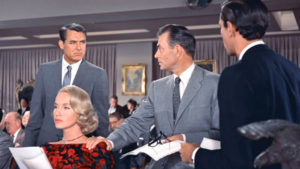 Mrs. T and I went on Sunday to see a big-screen showing of Billy Wilder’s Sunset Boulevard, the latest in the ongoing series of classic films that TCM and Fathom Events are piping into multiplexes throughout America.
Mrs. T and I went on Sunday to see a big-screen showing of Billy Wilder’s Sunset Boulevard, the latest in the ongoing series of classic films that TCM and Fathom Events are piping into multiplexes throughout America.
I considered writing about the experience, which we both found wholly enthralling, but it happens that I wrote a Wall Street Journal “Sightings” column last April about seeing Alfred Hitchcock’s North by Northwest as part of the same series, so I decided instead to post a lengthy excerpt from that column. I hope you enjoy it.
* * *
Turner Classic Movies, the cable channel that shows uncut, uncolorized classic films around the clock, has done more to improve the lives of movie buffs than anything or anyone since Thomas Edison. TCM’s latest venture, though, is worthy of special note: TCM Big Screen Classics, undertaken in collaboration with Fathom Events, screens classic films each month in multiplexes throughout the U.S. Now that the revival houses that used to show such films on a regular basis are on the way to extinction, most people “know” old movies solely from watching them on TV, or on hand-held devices. Thanks to TCM, you can see them the way they’re supposed to be seen.
Why the scare quotes? Because you don’t really “know” a film until you’ve seen it in a theater. Well into the ’60s, movies were normally shown in auditoriums equipped with screens up to 100 feet wide that held between 250 and 1,000 viewers (New York’s Radio City Music Hall seats 6,000). Golden-age directors took it for granted that their work would be seen on such screens, and when Hollywood embraced wide-screen filming in the ’50s to compete with TV, big-theater projection became even more central to the moviegoing experience.
All this started to change with the introduction of multiplex cinemas. Projection screens started shrinking, and theaters that continued to show older films increasingly did so in houses holding no more than 100 viewers. These miniaturized theaters were incapable of providing the eye-popping experience of viewing a classic film on a full-sized screen—and when the same films were reformatted to fit the TV screens of the ’60s and ‘70s, it became even harder for younger viewers to fully appreciate them. Squeezed-down “pan-and-scan” versions of wide-screen films are an assault on the integrity of works of visual art whose scenes were meticulously composed to fit the rectangular screens required by such processes as CinemaScope and VistaVision. Watching them on TV is like looking at “The Last Supper” through the wrong end of a toy telescope.
Fortunately for film buffs, TCM always telecasts letter-boxed versions of wide-screen films, and now that flat-screen TV sets are ubiquitous, they can be viewed at home with reasonable ease. But even the biggest TVs come nowhere near approximating the all-enveloping sensation of watching a wide-screen film in a full-sized theater.
 That’s why I made a point of going to a Big Screen Classics showing of “North by Northwest.” This was the first time that I’d seen Alfred Hitchcock’s 1959 masterpiece of suspense in a theater, and I can’t begin to tell you how many subtle details that typically go unnoticed in your living room all but exploded off the large screen on which I watched the film….
That’s why I made a point of going to a Big Screen Classics showing of “North by Northwest.” This was the first time that I’d seen Alfred Hitchcock’s 1959 masterpiece of suspense in a theater, and I can’t begin to tell you how many subtle details that typically go unnoticed in your living room all but exploded off the large screen on which I watched the film….
For me, though, it was even more instructive to watch “North by Northwest” in the company of a theater full of other people, many of whom were clearly seeing the film for the first time. When you’re watching it by yourself, it’s easy to forget that “North by Northwest” is less a cloak-and-dagger adventure story than a high romantic comedy with a light glaze of thriller sauce. Why is this the case? Because most of us tend not to laugh out loud when we’re alone. Not so the audience with whom I saw it last week. Instead of sitting somberly like a bunch of grim-faced graduate students, we all hooted at Ernest Lehman’s fizzy, flawlessly timed one- and two-liners (“I’ve got a job, a secretary, a mother, two ex-wives and several bartenders that depend upon me”). We even clapped at the end! That’s what the Big Screen Classics series is all about: It’s a priceless reminder of what we miss by watching classic films at home instead of on a big screen in the company of a happy audience….
* * *
Read the whole thing here.
To read about the experience of seeing William Wyler’s The Best Years of Our Lives in a theater, go here.
The original theatrical trailer for Sunset Boulevard:


